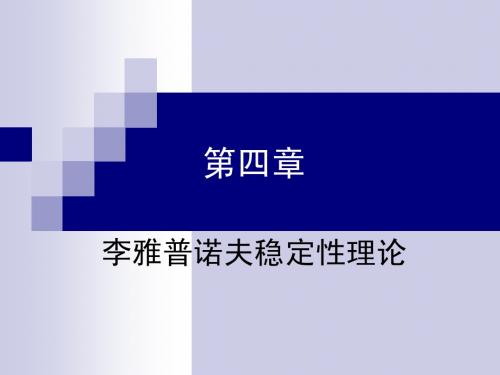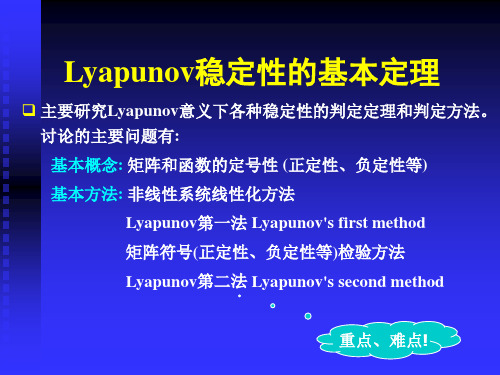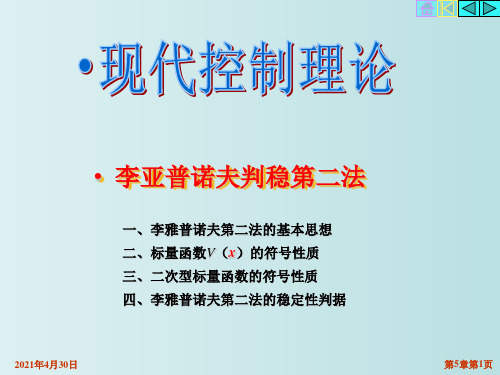- 1、下载文档前请自行甄别文档内容的完整性,平台不提供额外的编辑、内容补充、找答案等附加服务。
- 2、"仅部分预览"的文档,不可在线预览部分如存在完整性等问题,可反馈申请退款(可完整预览的文档不适用该条件!)。
- 3、如文档侵犯您的权益,请联系客服反馈,我们会尽快为您处理(人工客服工作时间:9:00-18:30)。
a nice Lie algebraic condition than the solvability of Lie algebra implies CQLF, which generalized the condition of [1]. The most updated and beautiful Lie algebra conditions were proved in [5]. Necessary and sufficient conditions for quadratic stabilization and a geometric description of the set of planar control systems were provided in [6]. A necessary and sufficient condition of CQLF was given in [7]. In fact, the approach in both [7] and [6] is based on constructing CQLF by considering the topological structure of the set of CQLFs. An alternative approach in constructing CQLF is using stable matrices Ai . The purpose of this paper is to investigate how far N-B structure can be extended for non-commutative set of stable matrices. In general the Lie algebra generated by them is not solvable. We intend to combine the Lie algebra structure with N-B structure to enlarge the applicability of N-B structure.
Denote by σ (A) the set of eigenvalues of A. Then we can show that in a cone area of α − β plane the N-B structure remains available: Theorem 1. Let {A1 , A2 } be a stable basis satisfying (5). Then A1 and A2 share an N-B type CQLF if the following two conditions are satisfied: α > −2min |Reσ (A2 )| ,
β < 2min |Reσ (A1 )|
σ
(6)
Proof. Choosing any positive definite matrix Q > 0, we set P0 A1 + β I 2 + A1 + β I 2
T
P0 = −Q
(7)
Then we know that (7) has a unique solution P0 > 0. Using this P0 , we set
Received September 14, 2005; in revised form September 19, 2006 Supported by National Natural Science Foundation of P. R. China (60274010, 60343001, 60221301, 60334040) 1. Institute of Systems Science, Chinese Academy of Sciences, Beijing 100080 DOI: 10.1360/aas-007-0202
[1] considerd a set of commutative stable matrices {A1 , · · · , AN } and proposed a method to construct CQLF, which is described in the following: Choose a positive definite matrix P0 and define Pi > 0, i = 1, · · · , N , recursively by Pi Ai + AT i Pi = −Pi−1 , i = 1, · · · , N (3)
Brief Paper
ACTA AUTOMATICA SINICA
Vol. 33, No. 2 February, 2007
Constructing Common Quadratic Lyapunov Functions for a Class of Stable Matrices
ZHU Ya-Hong1 CHENG Dai-Zhan1 QIN Hua-Shu1 Abstract Narendra and Balakrishnan proposed a way to construct a common quadratic Lyapunov function (CQLF)[1] , when a set of stable matrices are commutative. The purpose of this paper is to generalize the method to non-commutative and nonsolvable case. A modified constructing algorithm is proposed and certain conditions are provided to assure the resulting matrix being a CQLF. Next, the problem discussed is when a stable matrix can be added to a set of matrices with CQLF to construct a new CQLF for the enlarged set. Key words Switched system, common quadratic Lyapunov function, Lie algebra.
2
CQLF for Two Matrices
1
Introduction
Consider a switched linear system: x ˙ = A σ (t ) x (1)
where σ (t) : [0, +∞) → Λ is an right continuous function, Λ = {1, 2, · · · , N }. To assure the stability of switched system (1) under arbitrary switching, a common Lyapunov function is sufficient. A quadratic Lyapunov function, xT P x, with positive definite matrix P > 0 (or briefly, P ) is called a CQLF of { Aλ | λ ∈ Λ} if P Aλ + AT λ P < 0, ∀λ ∈ Λ (2)
No. 2
ZHU Ya-Hong et al.: Constructing Common Quadratic Lyapunov Functions for a Class of Stable Matrices P1 = − P2 A2 + A 2 Consider the set A of stable matrices satisfying (13). Then A share a CQLF PN , if the following two conditions are satisfied: max(ci i ) < 2min|Reσ (AN )| −Pi,N −1 + cN i PN −1 − (9) Where i = 1, · · · , N − 1. Proof. Using (14), we have Pi,N (AN + 2i I ) + (AN + 2i I )T Pi,N ¡ ¡ T T = PN Ai + AT i PN AN + AN PN Ai + Ai PN + ¡ T ci i PN Ai + Ai PN
In this section we consider the case of N = 2. First consider the involutive case and then non-involutive case. Definition 1. Let L ⊂ gl(n, R ) be a sub-algebra, dim(L) = N , and a linearly independent set of matrices A = {A1 , A2 , · · · , AN } ⊂ L are given. 1) A is called a stable basis of L if all Ai , i = 1, · · · , N are stable and they form a basis of L. In this case A is said to be involutive. 2) A is called a stable generator of L if all Ai , i = 1, · · · , N are stable and ALA = L. For N = 2, let {A1 , A2 } be a stable basis. Our question is: can we use the algorithm (3) to construct a CQLF for A1 and A2 . Since {A1 , A2 } is a basis, we have [A1 , A2 ] = αA1 + βA2 (5)





